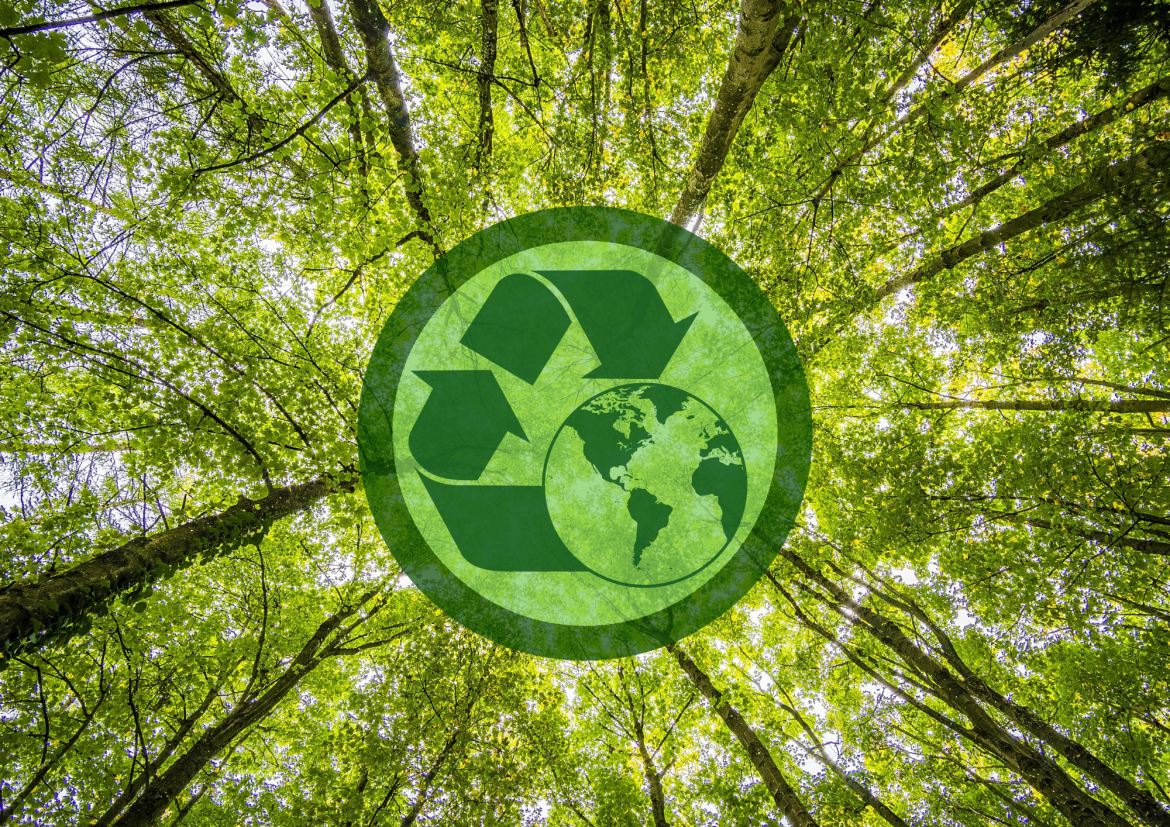Segregacja śmieci w dzisiejszych czasach nie jest już modna, jest wręcz obowiązkowa. Przeciętny Polak wytwarza rocznie około 315 kg śmieci. Odpady zabierają miejsce nie tylko drzewom, zwierzętom, ale i nam samym. Możemy odzyskać tę przestrzeń, jednak żeby to zrobić musimy jak najszybciej zacząć działać. Nawet niewielkie działania, regularnie powtarzane mogą przynieść spektakularne efekty. Jak zatem poprawnie segregować śmieci? Czym jest selektywna zbiórka odpadów? Co dzieje się z przetworzonymi odpadami? Oto kompletny poradnik dotyczący segregacji śmieci w domu.
Na czym polega segregacja śmieci?
Selekcja odpadów nie należy do zajęć szczególnie lubianych. Segregacja śmieci wytworzonych w naszych domach polega na zbieraniu odpadów do specjalnie oznakowanych pojemników lub worków, z podziałem na poszczególne rodzaje materiałów (surowców) z jakich zostały wyprodukowane. Plastik, szkło makulatura czy odpady organicznie mogą zostać ponownie użyte. Dzięki odpowiedniej segregacji pomagamy środowisku naturalnemu. Poznajmy zatem trzy kluczowe metody:
- segregacja u źródła – metoda najważniejsza, która rozpoczyna się już w naszych domach. Polega na ograniczeniu ilości odpadów podlegających utylizacji (np. składowaniu) poprzez odzyskanie surowców, które nadają się do ponownego użytku. Dzięki temu możemy wykorzystać je przy produkcji nowych wartościowych materiałów . Ułatwieniem w segregacji śmieci są wszelkiego rodzaju stojaki , kosze oraz worki w odpowiednich kolorach, w które można się zaopatrzyć z łatwością na rynku.
- segregacja workowa – prowadzona w gminach. Polega na zbieraniu odpadów do specjalnie dostarczonych przez gminę worków plastikowych i wprowadzona jest głównie na osiedlach domów jednorodzinnych
- segregacja kontenerowa – dotyczy w większości osób mieszkających w blokach i kamienicach, gdzie ustawione są zestawy kontenerów, za ich wywóz i opróżnianie również odpowiedzialna jest firma działająca na zlecenie gminy.
Poznaj super piątkę – jednolitego systemu segregacji odpadów
Główną zasadą Jednolitego Systemu Segregacji Odpadów (JSSO) jest to, ażeby bezwzględnie oddzielać surowce od odpadów, które nie nadają się do powtórnego przetworzenia. Jakie surowce zatem oddzielamy? Są to: metale i tworzywa sztuczne, papier, a także opakowania szklane i odpady biodegradowalne. Zbieranie osobno tych wszystkich materiałów pozwala uzyskać najbardziej pełnowartościowe surowce do ponownego przetworzenia. W woli przypomnienia poniżej grafiki, które dla jednych niech będą „przypominajką”, a dla pozostałych lekcją koedukacyjną 🙂
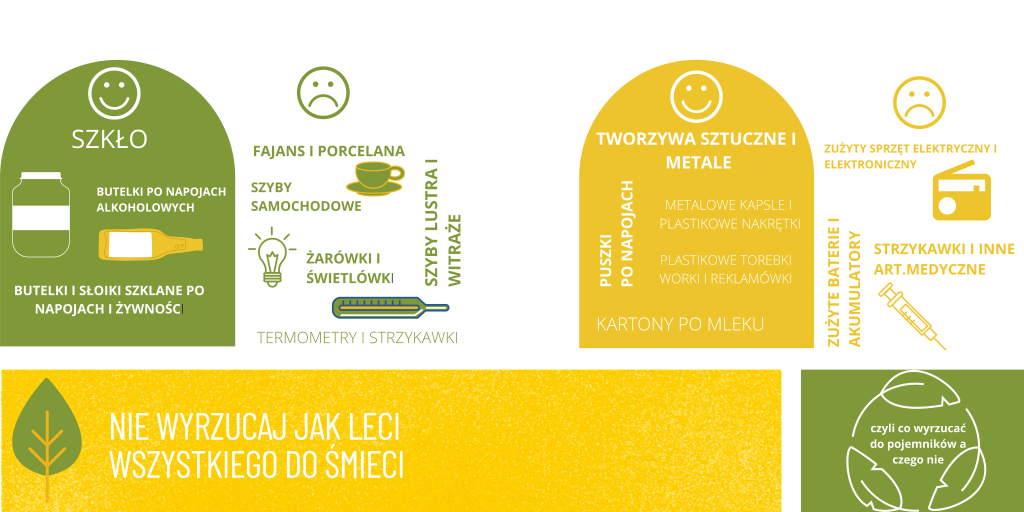
segregacja śmieci szklanych i plastikowych
Warto zaznajomić się z tym co można, a czego kategorycznie zabrania się wyrzucać do poszczególnych pojemników, aby odzyskać jak najwięcej surowców do ponownego użytku.
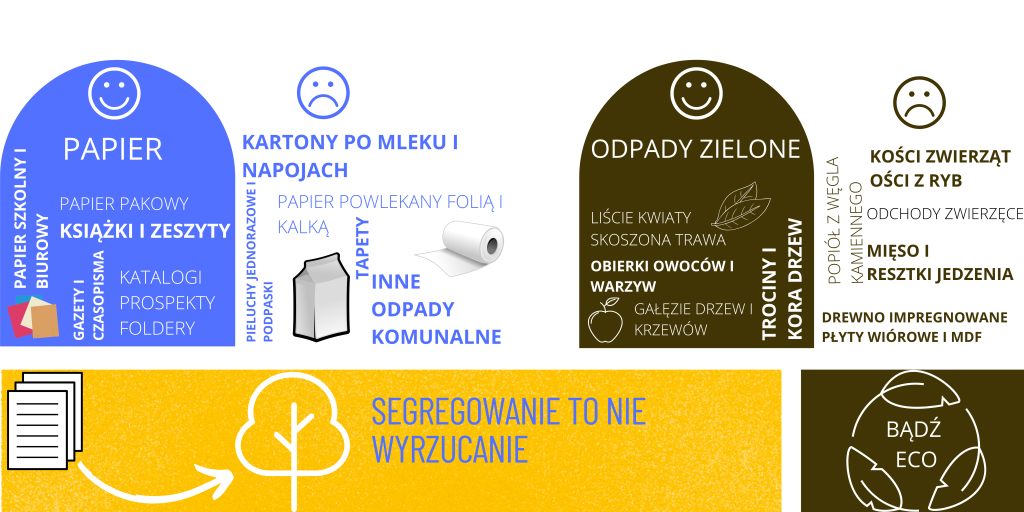
segregacja śmieci – selekcja odpadów biodegradowalnych i papierowych
Selekcja odpadów biodegradowalnych oraz papieru (makulatury) niesie wiele pożytku dla naszego środowiska. Z pozyskania tych surowców można zrobić wiele cennych rzeczy. Jakich? Przedstawimy Wam to w dalszej części artykułu.
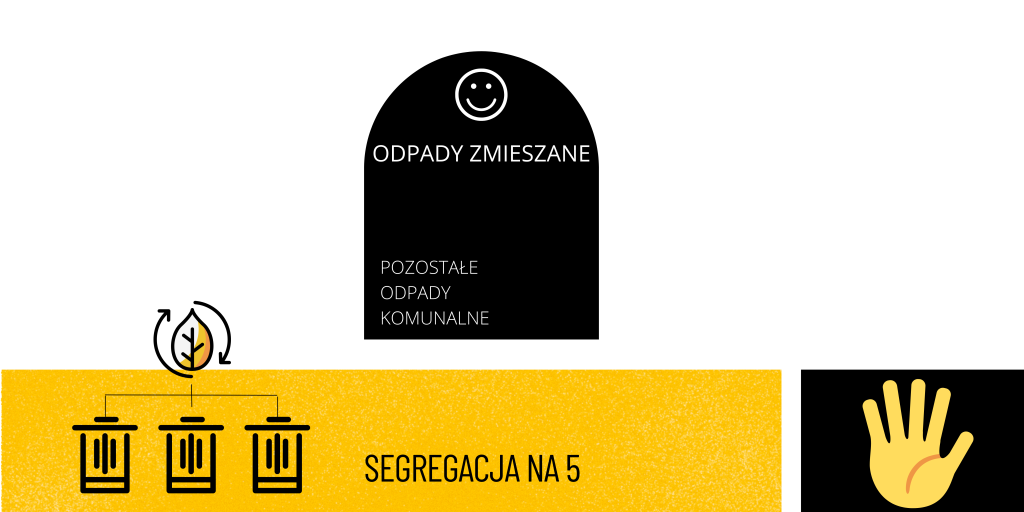
Pozostałe rodzaje śmieci, których nie jesteśmy w żaden sposób w stanie posegregować, wrzucamy do czarnego pojemnika – śmieci zmieszanych.
- Warto jednak pamiętać, aby nie wrzucać do niego odpadów niebezpiecznych takich jak: odpady zawierające rtęć np. termometry, świetlówki; baterie i akumulatory; zużyte kartridże i tonery; środki ochrony roślin; aerozole, rozpuszczalniki, resztki farb, lakierów i klejów czy zużyty sprzęt elektryczny.
Segregacja śmieci i recykling – budowanie przyszłości bez odpadów
Recykling tak naprawdę rozpoczyna się już w domu. Każdego dnia, kiedy otwieramy szafkę pod zlewem stajemy przed istotna decyzją: odzyskać czy zmarnować cenne surowce? Jeżeli wybierzemy tę pierwszą opcję, a więc postanowimy oddzielić odpady surowcowe od resztek jedzenia , to mają one ogromną szansę stać się nową ławką w parku, watą szklaną czy gazetą.
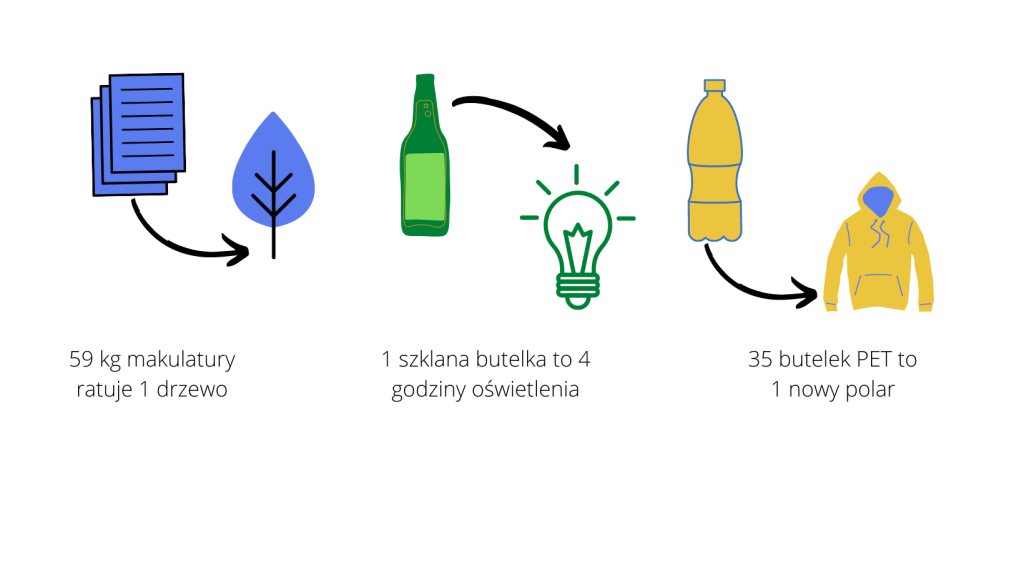
recykling
Powszechnym mitem na temat segregacji śmieci to przekonanie, że posegregowane odpady trafiają do jednej śmieciarki, która wszystko miesza, więc nasza praca w domu idzie na marne. Otóż nie! W tej kwestii wiele się zmieniło. Nowoczesne pojazdy odbierające posegregowane odpady mają zazwyczaj podział na różne przegrody, do których trafiają poszczególne odpady. Inne rozwiązanie to odbieranie każdego typu odpadów przez inną śmieciarkę. Dlaczego zatem warto segregować śmieci?
- Przede wszystkim segregowanie odpadów przynosi korzyści finansowe – segregując, płacimy mniej za odbiór śmieci. Jeśli będziemy pozbywać się odpadów jedynie w formie zmieszanej, rachunek za odbiór śmieci będzie kilkakrotnie wyższy.
- Koleją istotną rzeczą jest to, że recykling pozwala na oszczędność energii, surowców i środowiska naturalnego. Każda wykorzystana ponownie szklana butelka to oszczędność energii potrzebnej do oświetlenia pokoju żarówką przez około 4 godziny. Poddane recyklingowi odpady to także mniej wysypisk!
A co z pozostałymi śmieciami?
Kolejnym ważnym elementem w segregacji śmieci są odpady elektroniczne. Na rynku są coraz nowocześniejsze urządzenia elektryczne i elektroniczne. Coraz szybsze komputery, tablety, smartfony. Nowocześniejsze lodówki, odkurzacze czy suszarki. Gdzie zatem oddać stare urządzenia? Na pewno można je bezpłatnie oddać do punktu selektywnej zbiórki odpadów komunalnych, sklepów sprzedających sprzęt RTV i AGD, jak również podczas częstych zbiórek organizowanych w gminach i miastach. Nie pozwólmy zatem, aby ten sprzęt został wyrzucony do zmieszanych śmieci komunalnych.
Nasz świat w naszych rękach
Co możemy zatem zrobić, aby chronić nasze środowisko? Wodę w butelkach plastikowych zamienić na przefiltrowaną wodę z kranu, idąc na zakupy warto zabrać ze sobą torbę wielokrotnego użytku. A jeżeli jesteś tym szczęśliwcem, który posiada własny ogród i ma możliwość przerobienia śmieci biodegradowalnych na kompost – zachęcamy do założenia kompostownika ogrodowego. Jak to zrobić i co do niego wrzucić dowiecie się z filmu.
Jeszcze nie wszystko stracone. Zacznijmy wspólną walkę o naszą przyszłość. Bądźmy świadomi i odpowiedzialni za działania, które przyczynią się najlepiej do całkowitego wyeliminowania wytwarzania jakichkolwiek odpadów.
